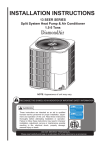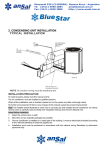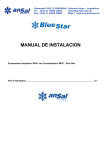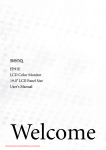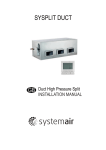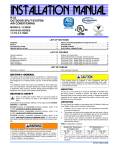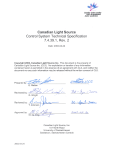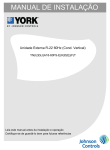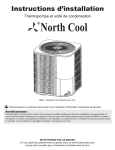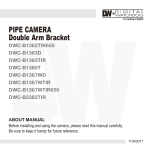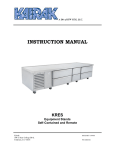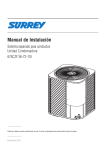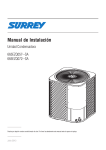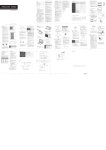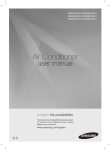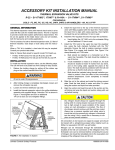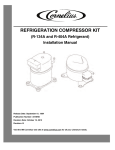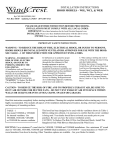Transcript
This document is customer property and is to remain with this unit. These instructions do not cover all the different variations of systems nor does it provide for every possible contingency to be met in connection with installation. All phases of this installation must comply with NATIONAL STATE AND LCOAL CODES. If additional information is required please contact your local distributor. TABLE OF CONTENTS INSTALLATION MANUAL CONTENT PAGE 1.0 SAFETY..................................................................................................................1 1.1 INSPECTION....................................................................................................1 1.2 LIMITATION......................................................................................................1 2.0 GENERAL..............................................................................................................1 3.0 UNIT INSTALLATION............................................................................................2 3.1 LOCATION.......................................................................................................2 3.2 GROUND INSTALLATION...............................................................................2 3.3 ROOF INSTALLATION.....................................................................................3 3.4 UNIT PLACEMENT..........................................................................................3 3.5 PRECAUTIONS DURING LINE INSTALLATION.....................................................3 3.6 PRECAUTIONS DURING BRAZING OF LINES......................................................3 3.7 PRECAUTIONS DURING BRAZING SERVICE VALVE..........................................4 3.8 FACTORY-PREFERRED TIE-DOWN METHOD......................................................4 3.9 REMOVING THE TOP PANEL AND MOTOR..........................................................5 4.0 ELECTRICAL CONNECTIONS......................................................................................5 4.1 GENERAL INFORMATION & GROUNDING ..........................................................5 4.2 FIELD CONNECTIONS POWER WIRING .............................................................5 5.0 EVACUATION................................................................................................................6 6.0 SYSTEM CHARGE.......................................................................................................6 6.1 MEASUREMENT METHOD....................................................................................6 6.2 SUB-COOLING CHARGING METHOD..................................................................6 7.0 SYSTEM OPERATION..................................................................................................6 7.1 COMPRESSOR CRANKCASE HEATER (CCH).....................................................6 7.2 HIGH-PRESSURE SWITCH FAULT (HEAT PUMP ONLY).....................................6 7.3 LOW-PRESSURE SWITCH (HEAT PUMP ONLY)..................................................7 7.4 TEMPERATURE SENSOR (HEAT PUMP ONLY)...................................................7 8.0 INSTRUCTING THE OWNER.......................................................................................7 8.1 MAINTENANCE......................................................................................................7 CONDENSING UNITS 1.5-5Tons 1.0 SAFETY This is a safety alert symbol. When you see this symbol on labels or in manuals, be alert to the potential for personal injury. This is an attention alert symbol. When you see this symbol on labels or in manuals, be alert to the potential for personal injury. Understand and pay particular attention to the signal words DANGER, WARNING, or CAUTION. An all-pole disconnection device which has at least 3mm clearances in all poles , and have a leakage current that may exceed 10mA, the residual current device (RCD) having a rated residual operating current not exceeding 30mA, and disconnection must be incorporated in the fixed wiring in accordance with the wiring rules. 1.1 INSPECTION As soon as a unit is received, it should be inspected for possible damage during transit. If damage is evident, the extent of the damage should be noted on the carrier's delivery receipt. A separate request for inspection by the carrier's agent should be made in writing. See Local distributor for more information. Requirements For Installing/Servicing R22 Equipment ● Gauge sets, hoses, refrigerant containers, and recovery system must be designed to handle the POE or PVE type oils. ● Manifold sets should be 800 PSIG high side and 250 PSIG low side with 550 PSIG Iow side restart. ● All hoses must have a 700 PSIG service pressure rating. ● Leak detectors should be designed to detect refrigerant. ● Recovery equipment (including refrigerant recovery containers) must be specifically designed to handle R22. ● Do not use an R410A TXV. ● A liquid-line filter drier is required on every unit. see the Fig.1 DANGER indicates an imminently hazardous situation, which, if not avoided, will result in death or serious injury. WARNING indicates a potentially hazardous situation, which, if not avoided, could result in death or serious injury. CAUTION indicates a potentially hazardous situation, which, if not avoided may result in minor or moderate injury. It is also used to alert against unsafe practices and hazards involving only property damage. WARNING Improper installation may create a condition where the operation of the product could cause personal injury or property damage. Improper installation, adjustment, alteration, service or maintenance can cause injury or property damage. Refer to this manual for assistance or for additional information, consult a qualified contractor, installer or service agency. CAUTION RECOGNIZE THIS SYMBOL AS AN INDICATION OF IMPORTANT SAFETY INFORMATION This product must be installed in strict compliance with the installation instructions and any applicable local, state, and national codes including, but not limited to building, electrical, and mechanical codes. WARNING These instructions are intended as an aid to qualified licensed service personnel for proper installation, adjustement and operation of this unit. Read these instructions thoroughly before attempting installation or operation. Failure to follow these instruction may result in improper installation, adjustment, service or maintencance possibly resulting in fire, electrical shock, proerty damage, personal injury or death. WARNING FIRE OR ELECTRICAL HAZARD Failure to follow the safety warnings exactly could result in serious injury, death or property damage. A fire or electrical hazard may result causing property damage, personal injury or loss of life. The appliance shall be installed in accordance with national wiring regulations. DO NOT DESTROY THIS MANUAL Please read carefully and keep in a safe place for future reference by a serviceman. Do not operate your air conditioner in a wet room such as a bathroom or laundry room. LIQUID SERVICE VALVE LIQUID-LINE FILTER-DRIER Fig.1 Filter-Drier insatllation 1.2 LIMITATIONS The unit should be installed in accordance with all National, State and Local Safety Codes and the limitations listed below: 1. Limitations for the indoor unit, coil and appropriate accessories must also be observed. 2. The outdoor unit must not be installed with any duct work in the air stream. The outdoor fan is the propelle type and is not designed to operate against any additional external static pressure. 3. The maximum and minimum conditions for operation must be observed to assure a system that will give maximum performance with minimum service. 4. This unit is not designed to operate with a low ambient kit. Do not modify the control system to operate with any kind of Iow ambient kit. 5. The maximum allowable line length for this product is 75 feet. 2.0 GENERAL The outdoor units are designed to be connected to a matching indoor coil with sweat connect lines. Sweat connect units are factory charged with refrigerant for a matching indoor coil plus 25 feet of field supplied lines. Installation manual 1 Matching indoor coils are available with a thermal expansion valve or an orifice liquid feed sized for the most common usage. The orifice size and/or refrigerant charge may need to be changed for some indoor-out-door unit combinations,elevation differences or total line lengths. W AIR DISCHARGE ALLOW 60” MINIMUM CLEARANCE. NOTE: GRILL APPEARANCE MAY VARY. CONTROL WIRING 1-11/32” (34.5mm) L POWER WIRING 7/8” (22.2mm) LIQUID LINE CONNECTION VAPOR LINE CONNECTION Insulated Liquid Line Fig.3 Tubing Hanger 3.7 PRECAUTIONS DURING BRAZING SERVICE VALVE Precautions should be taken to prevent heat damage to service valve by wrapping a wet rag around it as shown in Fig. 6. Also, protect all painted surfaces, insulation, during brazing. After brazlng cool joint with wet rag. The outdoor unit must be connected to the indoor coil using field supplied refrigerant grade copper tubing that is internally clean and dry. Units should be installed only with the tubing sizes for approved system combinations. The charge given is applicable for total tubing lengths up to 25 feet. Valve can be opened by removing the plunger cap and fully inserting a hex wrench into the stem and backing out counter-clockwise until valve stem just touches the chamfered retaining wall. Connect the refrigerant lines using the following procedure: Dimensions (Inches) 18000 24000 36000 36000 36000 36000 "L" in [mm] 21-7/8[554] 21-7/8[554] 21-7/8[554] 23-5/8[600] 23-5/8[600] 23-5/8[600] Liquid in 1/4 3/8 3/8 3/8 3/8 3/8 36000 36000 36000 48000 48000 29-7/8[759] 24-15/16[633] 29-7/8[759] 29-7/8[759] 29-7/8[759] 21-7/8[554] 28[710] 28[710] 28[710] 28[710] 21-7/8[554] 28[710] 28[710] 28[710] 28[710] 3/8 3/8 48000 29-7/8[759] 29-7/8[759] 29-7/8[759] 33-3/16[843] 23-5/8[600] 23-5/8[600] 28[710] 28[710] 23-5/8[600] 23-5/8[600] 28[710] 28[710] 3.0 UNIT INSTALLATION 3.1 LOCATION Before starting the installation, select and check the suitability of the location for both the indoor and outdoor unit. Observe all limitations and clearance requirements. The outdoor unit must have sufficient clearance for air entrance to the condenser coil, for air discharge and for service access. See Fig.5. NOTE For multiple unit installations, units must be spaced a minimum of 18 inches apart. (Coil face to coil face.) If the unit is to be installed on a hot sun exposed roof or a black-topped ground area, the unit should be raised sufficiently above the roof or ground to avoid taking the accumulated layer of hot air into the outdoor unit. Provide an adequate structural support. 3.2 GROUND INSTALLATION Using a larger than specified line size could result in oil return problems. Using too small a line will result in loss of capacity and other problems caused by insufficient refrigerant flow. Slope horizontal vapor lines at least 1" every 20 feet toward the outdoor unit to facilitate proper oil return. Vapor in 1/2 5/8 3/4 3/4 3/4 7/8 3/4 3/4 3/4 3/4 7/8 3/4 3/4 3/4 3/4 3/8 3/8 3/8 3/8 3/8 3/8 3/8 1. Remove the cap and Schrader core from both the liquid and vapor service valve service ports at the outdoor unit. Connect Iow pressure nitrogen to the liquid line service port. NOTE Refrigerant Connection Service Valve Size "W" in [mm] 21-7/8[554] 21-7/8[554] 21-7/8[554] 23-5/8[600] 23-5/8[600] 23-5/8[600] 60000 60000 Tape Correct Incorrect FIG.2 DIMENSIONS "H" in [mm] 24-15/16[633] 24-15/16[633] 24-15/16[633] 29-7/8[759] 24-15/16[633] 24-15/16[633] 60000 Dry nitrogen should always be supplied through the tubing while it is being brazed, because the temperature required is high enough to cause oxidation of the copper unless an inert atmosphere is provide. The flow of dry nitrogen should continue until the joint has cooled. Always use a pressure regulator and safety valve to insure that only low pressure dry nitrogen is introduced into the tubing.Only a small flow is necessary to displace air and prevent oxidation. The maximum length of refrigeration lines for outdoor to indoor unit should not exceed 75 feet. AIR INLETS LOUVERED PANELS ALLOW 18” MINIMUM CLEARANCE DIMENSIONAL DATA Unit Model (Btu/h) 3.4 UNIT PLACEMENT CAUTION Sheet Metal Hanger Insulated Vapor Line When installing units on a roof, the structure must be capable of supporting the total weight of the unit, including a padded frame unit, rails, etc., which should be used to minimize the transmission of sound or vibration into the conditioned space. 1. Provide a base in the pre-determined location. 2. Remove the shipping carton and inspect for possible damage. 3. Compressor tie-down bolts should remain tightened. 4. Position the unit on the base provided. H SERVICE ACCESS ALLOW 24” CLEARANCE 3.3 ROOF INSTALLATION 3.5 PRECAUTIONS DURING LINE INSTALLATION 1. Install the lines with as few bends as possible. Care must be taken not to damage the couplings or kink the tubing. Use clean hard drawn Copper tubing where no appreciable amount of bending around obstruction is necessary, if soft copper must be used, care must be taken to avoid sharp bends which may cause a restriction. 2. The lines should be installed so that they will not obstruct service access to the coil, air handling system or filter. The unit may be installed at ground level on a solid base that will not shift or settle, causing strain on the refrigerant lines and possible leaks. Maintain the clearances shown in Fig.5 and install the unit in a level position. Normal operating sound levels may be objectionable if the unit is placed directly under windows of certain rooms (bedrooms, study, etc.). Top of unit discharge area must be unrestricted for at least 6 feet above the unit. WARNING The outdoor unit should not be installed in an area where mud or ice could cause personal injury. Elevate the unit sufficiently to prevent any blockage of the air entrances by snow in areas where there will be snow accumulation. Check the local weather bureau for the expected snow accumulation in your area. Isolate the unit from rain gutters to avoid any possible wash out of the foundation. 3. Care must also be taken to isolate the refrigerant lines to minimize noise transmission from the equipment to the structure. 4. The vapor line and liquid line must be insulated with a minimum of 1/2" foam rubber insulation (Armafiex or equivalent). Tape and suspend the refrigerant lines as shown. DO NOT allow tube metal-to-metal contact. See Fig. 4. 5. Use PVC piping as a conduit for all underground installations as shown in Fig. 4. Buried lines should be kept as short as possible to minimize the build up of liquid refrigerant in the vapor line during long periods of shutdown. 6. Pack fiberglass insulation and a sealing material such as perma gum around refrigerant lines where they penetrate a wall to reduce vibration and to retain some flexibility. Fig.4 Underground Installation wet rag TO INDOOR BLOWER WEATHERPROOF DISCONNECT SWITCH 24V co TO POWER SUPPLY TO COIL Fig.6 Heat Protection Seal opening(s) with permagumor equivalent 24 inch SERVICE ACCESS CLEARANCE NOTE:All outdoor wiring must be weatherproof Fig.5 Typical Installtion 3.6 PRECAUTIONS DURING BRAZING OF LINES All outdoor unit and evaporator coil connections are copper-to-copper and should be brazed with a phosphorous-copper alloy material such as Silfos-5 or equivalent. DO NOT use soft solder. The outdoor units have reusable service valves on both the liquid and vapor connections. The total system refrigerant charge is retained within the outdoor unit during shipping and installation. The reusable service valves are provided to evacuate and charge per this instruction. Serious service problems can be avoided by taking adequate precautions to assure an internally clean and dry system. Installation manual 3 see detail A 4.0 ELECTRICAL CONNECTIONS 4.1 GENERAL INFORMATION & GROUNDING Check the electrical supply to be sure that it meets the values specified on the unit nameplate and wiring label. Power wiring, control (Iow voltage) wiring, disconnect switches and over current protection must be supplied by the installer. Wire size should be sized per requirements. #7 Χ 3/8“ screws CAUTION 1/4” Χ 1-3/4“ Hex Washer Head Concrete Screws (3/16” Pilot Hole Needed. Pilot Hole 1/4” deeper Than The Fastener Embedment) Fig.7 FACTORY-PREFERRED TIE-DOWN METHOD IMPORTANT Do not use screws longer than indicated 1/4” * 2/3” and make sure that the brace is attached on center of base ban where indicated in Fig.7. Damage will occrue to system. Step 5: Drill 4 holes into cement base ensuring holes are 2 1//2”dp. Step 6: Assemble unit to cement pad using 4 1/4” * 2” Hex washer head cement screws make sure not to over tighten. Step 7:Finish unit assembly process as indicated in installation manual. REQUIRED PARTS LIST NOTE: ALL PARTS ACAILABLE THROUGH LOCAL HARDWARE SUPPL. DESCRIPTION QUANTITY 1/4” Χ 3/8” Hex Washer Head Concrete Screws 4 1/8” Χ 1-1/2” Χ W (width of unit +4”) Metal straps 4 3/8” Washers 4 All field wiring must USE COPPER CONDUCTORS ONLY and be in accordance with Local, National Fire, Safety & Electrical Codes. This unit must be grounded with a separate ground wire in accordance with the above codes. The complete connection diagram and schematic wiring label is located on the inside surface of the unit service access panel and this instruction. 5.0 EVACUATION It will be necessary to evacuate the system to 500 microns or less. If a leak is suspected, leak test with dry nitrogen to locate the leak. Repair the leak and test again. To verify that the system has no leaks, simply close the valve to the vacuum pump suction to isolate the pump and hold the system under vacuum. Watch the micron gauge for a few minutes. If the micron gauge indicates a steady and continuous rise, it's an indication of a leak. If the gauge shows a rise, then levels off after a few minutes and remains fairly constant, its an indication that the system is leak free but still contains moisture and may require further evacuation if the reading is above 500 microns. 6.0 SYSTEM CHARGE CAUTION R22 refrigerant cylinders are rose colored, and have a dip tube which allows liquid to flow out of the cylinder in the Upright Position. Always charge the system slowly with the tank in the upright position. The factory charge in the outdoor unit includes enough charge for the unit, a 25 ft. line set and the match indoor coil. Some indoor coil matches may require additional charge. See tabular data sheet provided in unit literature packet for charge requirements. 4.2 FIELD CONNECTIONS POWER WIRING 1. Install the proper size weatherproof disconnect switch outdoors and within sight of the unit. 2. Remove the screws at the side of the corner cover. Slide corner cover down and remove from unit. See Fig. 9. 3. Run power wiring from the disconnect switch to the unit. 4. Route wires from disconnect through power wiring opening provided and into the unit control box. 3.9 REMOVING THE TOP PANEL AND MOTOR 1/2” bolt CAUTION Do not leave the system open to the atmosphere. Unit damage could occur due to moisture being absorbed by the mineral oil in the system. This type of oil is highly susceptible to moisture absorption. The "TOTAL SYSTEM CHARGE" must be permanently stamped on the unit data plate. Total system charge is determined as follows: I. Determine outdoor unit charge from tabular data sheet. 2. Determine indoor coil adjustment from tabular data sheet. 3. Calculate the line charge using the tabular data sheet if line length is greater than 25 feet. 4. Total system charge = item 1 + item 2 + item 3. 5. Permanently stamp the unit data plate with the total amount of refrigerant in the system. Use the following subcooling charging method whenever additional refrigerant is required for the system charge. A superheat charging method is not suitable for TXV equipped systems. 5/16” bolts POWER WIRING CONTROL WIRING CAUTION CORNER COVER Refrigerant charging should only be carried out by a quafified air conditioning contractor. Fig. 8 COVER AND FAN Fig.9 Typical Field Wiring When motor requires changing follow the steps below: Step 1: Go into electrical panel, disconnect motor power lines. IMPORTANT NOTE Disconnect main power to unit. Severe burns and electrical shock will occure if you do not disconnect main power. 5. Install the proper size time-delay fuses or circuit breaker, and make the power supply connections. 6. Energize the crankcase heater if equipped to save time by preheating the compressor oil while the remaining installation is completed. Installation manual 5 QS01I-034AW The design and specifications are subject to change without prior notice for product .improvement.Consult with the sales agency or manufacturer for details. 202000100264 20140103 6.1 MEASUREMENT METHOD If a calibrated charging cylinder or accurate weighing device is available, add refrigerant accordingly. Installation manual 6 LIQUID SIZE VAPOR LIQUID(LONG-LINE) Tube Diameter 24K 3/8 5/8 3/8 36K 3/8 3/4 3/8 48K 3/8 3/4 3/8 60K 3/8 3/4 3/8 NOTE 1. Tube diameters are for lengths up to 50 equivalent ft and/or 20 ft vertical differential. 2. Do not increase or decrease tubing sizes. NOTE Line set and indoor coil can be pressurized, to 250 psig with dry nitrogen and leak tested with a bubble type leak detector. Than release the nitrogen charge. Do not use the system refrigerant in the outdoor unit to purge or leak test. 10. Replace cap on service ports. Do not remove the flare caps from the service ports except when necessary for servicing the system. CAUTION 11. Release the refrigerant charge into the system. Open both the liquid and vapor valves by removing the plunger cap and with an hex wrench back out counter-clockwise until valve stem just touches the chamfered retaining wall. 12. Replace plunger cap finger tight, then tighten an additional 1/12 turn (1/2 hex flat). Cap must be replaced to prevent leaks. ignal 2 Note: When changing the motor, please top cover first. UNIT Do not connect manifold gauges unless trouble is suspected. Approximately 3/4 ounce of refrigerant will be lost each time a standard manifold gauge is connected. ntrol s Installation manual Step 2: Remove cover (be careful of motor wires) Step 3: Be sure to place fan cover unit on the ground as indicated in Fig.8. IMPROTANT NOTE Do not place or lean fan blades on ground or against surface. Step 4: Remove fan motor by removing 4 5/16” bolts from cover. Step 5: Remove fan blade from motor by removing 1 1/2” and place fan on the ground. Step 6: Reverse removal process to reinstall the fan and motor. IMPROTANT NOTE When connecting motor wires be sure to check motor direction. service valve 48 inch OVERHEAD CLEARANCE 12 inch REAR AND SIDES Table 1: Refrigerant Connections and Recommended Liquid and Vapor Tube Diameters (ln.) CAUTION Compressor damage will occur if system is improperly charged. On new system installations, charge system per tabular data sheet for the matched coil and follow guidelines in this instruction. Check flare caps on service ports to be sure they are leak tight. DO NOT OVERTIGHTEN (between 40 and 60 inch -lbs. Maximum) 6.2 SUB-COOLING CHARGING METHOD. For the cooling operation, the recommended subcooling is typically around 10 °F. This may vary greatly based on each unique system. 1. Set the system running in the cooling mode by setting the thermo, stat at least 6°F below the room temperature. 2. Operate the system for a minimum of 15-20 minutes. 3. Refer to the tabular data sheet for the recommended airflow and verify this indoor airflow (it should be about 400 SCFM per ton). 4. Measure the liquid refrigerant pressure “P” and temperature “T” at the service valve 5. Calculate the saturated liquid temperature “ST” from Table 2 on the last page of this document. 6. Subcooling temperature “TC” = Saturated Temperature (ST) - Liquid Temp (T). Example: The pressure “P” and temperature “T” measured at the liquid service port is 360 Psig and 93 °F. From Table 2, the saturated temperature for 360 Psig is 109° . The subcooling temperature “TC” =109° -93° =16° F Add charge if the calculated subcooling temperature “TC” in Step 6 is lower than the recommended level. Remove and recover the refrigerant if the subcooling “TC” is higher than the recommended level. 7.0 SYSTEM OPERATION 7.1 COMPRESSOR CRANKCASE HEATER (CCH) While scroll compressors usually do not require crankcase heaters, there are instances when a heater should be added. Refrigerant migration during the off cycle can result in a noisy start up. Add a crankcase heater to minmize refrigeration mirgration, and to help eliminate any start up noise or bearing “wash out.” All heaters are located on the lower half of the compressor shell. Its purpose is to drive refrigerant from the compressor shell during long off cycles, thus preventing damage to the compressor during start-up. At initial start-up or after extended shutdown periods, make sure the heater is energized for at least 12 hours before the compressor is started. (Disconnect switch on and wall thermostat off.) 2. Braze the liquid line to the liquid valve at the outdoor unit. Be sure to wrap the valve body with a wet rag. Allow the nitrogen to continue flowing. Refer to the Tabular Data Sheet for proper liquid line sizing. 3. Carefully remove the rubber plugs from the evaporator liquid and vapor connections at the indoor coil. 4. Braze the liquid line to the evaporator liquid connection. Nitrogen should be flowing through th e evaporator coil. 5. Slide the plastie cap away from the vapor connection at the indoor coil. Braze the vapor line to the evaporator vapor connection. Refer to the Table 1 for proper vapor line sizing. 6. Protect the vapor valve with a wet rag and braze the vapor line connection to the outdoor unit. The nitrogen flow should be exiting the system from the vapor service port connection. After this connection has cooled, remove the nitrogen source from the liquid fitting service port. 7. Replace the Schrader core in the liquid and vapor valves. 8. Leak test all refrigerant piping connections including the service port flare caps to be sure they are leak tight. DO NOT OVER TIGHTEN (between 40 and 60 inch -lbs. maximum). 9. Evacuate the vapor line, evaporator and the liquid line, to 500 microns or less. WARNING Never attempt to repair any brazed connections while the system is under pressure. Personal injury could result. See "System Charge" section for checking and recording system charge. 3.8 FACTORY-PREFERRED TIE-DOWN METHOD IMPORTANT NOTE: These instructions are intended as a method to tie-down system to cement slab as a securing procedure for high and areas. It is recommended to check Local codes for tie-down methods and protocols. Step 1: Prior to installing clear pad of debris. Step 2: Ensure cement pad is level. IMPORTANT Then cement pad must be made of HVAC-approved materials and must be the proper thickness to accommodate fasteners. Step 3: Center unit onto pad. Step 4: Fasten 4 L-shaped stainless steel braces onto cabinet base using 4 1/4” * 1/2” Hex washer head stainless steel self tapping screws where indicated in detail Fig.7. Installation manual 4 7.3 LOW-PRESSURE SWITCH (Heat pump only) The Unit is equipped with a low-pressure switch which is connected to the main board. If the Iow-pressure switch opens for more than five seconds, the control will cause a soft lockout condition. 7.4 TEMPERATURE SENSOR (Heat pump only) The unit have two temperature sensors, which are called “T3” and “T4”, “T3” means pipe temperature sensor, “T4” means outdoor unit circumstance temperature sensor. When the temperature sensor was damaged, the system would closed. 8.0 INSTRUCTING THE OWNER Assist owner with processing Warranty cards and/or online registration. Review Owners Guide and provide a copy to the ower and guidance on proper operation and mainteance. Instruct the owner or the operator how to start, stop and adjust temperature setting. The installer should instruct the owner on proper operation and maintenance of all other system components. 8.1 MAINTENANCE 1. Dirt should not be allowed to accumulate on the outdoor coils or other parts in the air circuit. Clean as often as necessary to keep the unit clean. Use a brush, vacuum cleaner attachment, or other suitable means. 2. The outdoor fan motor is permanently lubricated and does not require periodic oiling. 3. If the coil needs to be cleaned, it should be washed with Calgon Coilclean (mix one part Coilclean to seven parts water). Allow solution to remain on coil for 30 minutes before rinsing with clean water. Solution should not be permitted to come in contact with painted surfaces. 4. Refer to the furnace or air handler instructions for filter and blower Motor maintenance. 5. The indoor coil and drain pan. should be inspected and cleaned regularly to prevent outdoors and assure proper drainage. CAUTION It is unlawful to knowingly vent, release or discharge refrigerant into the open air during repair, service, maintenance or the final disposal of this unit. When the system is functioning properly and the owner has been fully instructed, secure the owner’s approval. 7.2 HIGH-PRESSURE SWITCH FAULT (Heat pump only) The Unit is equipped with a high-pressure switch that is connected to the main board, If the high-pressure switch opens for more than 40 milliseconds, the control will de-energize the compressor and store and display the appropriate fault code. If the pressure switch closes and a thermostat call for compressor operation is present, the control will apply the three-minute anti-short cycle delay timer and start the compressor when the timer expires. Installation manual 7
